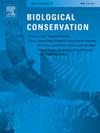让当地社区参与森林生物多样性保护的战略在马达加斯加的有效性有限:来自文献的教训
IF 4.9
1区 环境科学与生态学
Q1 BIODIVERSITY CONSERVATION
引用次数: 0
摘要
为了解决当前的生物多样性危机,世界各地已经实施了各种保护方法,以使当地社区参与生物多样性保护。在生物多样性热点国家马达加斯加,这些方法包括保护区、基于社区的保护和基于市场的保护。然而,它们各自的生态、社会经济和社会文化效益仍然知之甚少。本研究旨在通过系统的文献综述来填补这一知识空白。在通过标准化搜索和筛选确定的关于马达加斯加森林保护的480份出版物中,选择了156份进行深入的全文分析。通过结合定量和定性方法,我们的结果揭示了总体上积极的生态结果,但负面的社会经济和文化影响。虽然文献对保护行动在减少森林砍伐方面的有效性提出了不同的发现,但受保护的森林已经证明了改善生物多样性的结果。然而,这些生态效益是以当地社区为代价的,尤其是最贫困的家庭,他们往往得不到足够的补偿。保护项目提出的替代生计活动往往不适合当地情况,当地精英往往会攫取大部分保护利益,加剧了不平等和地方冲突。所有三种保护方法都显示出类似的趋势,表明无论采用何种策略,都面临着反复出现的挑战。这些文献强调了在平衡生态结果和人类福祉的同时实现更有效保护的策略。这包括对地方保护行动的持续投资、真正的共同管理框架、社区赋权以及研究人员和地方利益相关者之间更强有力的合作。尽管本研究的重点是马达加斯加,但本研究确定的挑战和解决方案对生物多样性保护利益相关者具有更广泛的全球相关性。本文章由计算机程序翻译,如有差异,请以英文原文为准。
Strategies to engage local communities in forest biodiversity conservation had limited effectiveness in Madagascar: Lessons from the literature
To address the current biodiversity crisis, various conservation approaches have been implemented worldwide to engage local communities in biodiversity conservation. In Madagascar, a biodiversity hotspot, these approaches include protected areas, community-based conservation, and market-based conservation. However, their respective ecological, socio-economic, and socio-cultural effectiveness remains poorly understood. This study aimed to fill this knowledge gap through a systematic literature review. Out of 480 publications on forest conservation in Madagascar identified through standardized searches and screening, 156 were selected for in-depth full-text analysis. By combining quantitative and qualitative approaches, our results revealed generally positive ecological outcomes but negative socio-economic and cultural impacts. While the literature presents mixed findings on the effectiveness of conservation actions in reducing deforestation, protected forests have demonstrated improved biodiversity outcomes. However, these ecological gains come at a cost to local communities, especially the poorest households, who often receive inadequate compensation. Alternative livelihood activities proposed by conservation programs are often ill-suited to local contexts, and local elites tend to capture most conservation benefits, exacerbating inequalities and local conflicts. All three conservation approaches display similar trends, indicating recurring challenges regardless of the strategy employed. The literature highlights strategies to achieve more effective conservation while balancing ecological outcomes and human well-being. These include sustained investment in local conservation actions, genuine co-management frameworks, community empowerment, and stronger collaboration between researchers and local stakeholders. Although focused on Madagascar, the challenges and solutions identified in this study have broader global relevance for biodiversity conservation stakeholders.
求助全文
通过发布文献求助,成功后即可免费获取论文全文。
去求助
来源期刊

Biological Conservation
环境科学-环境科学
CiteScore
10.20
自引率
3.40%
发文量
295
审稿时长
61 days
期刊介绍:
Biological Conservation is an international leading journal in the discipline of conservation biology. The journal publishes articles spanning a diverse range of fields that contribute to the biological, sociological, and economic dimensions of conservation and natural resource management. The primary aim of Biological Conservation is the publication of high-quality papers that advance the science and practice of conservation, or which demonstrate the application of conservation principles for natural resource management and policy. Therefore it will be of interest to a broad international readership.
 求助内容:
求助内容: 应助结果提醒方式:
应助结果提醒方式:


